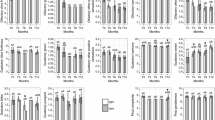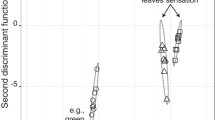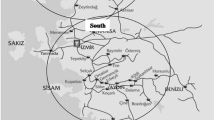Abstract
Olive oil quality grading is traditionally assessed by human sensory evaluation of positive and negative attributes (olfactory, gustatory, and final olfactory–gustatory sensations). However, it is not guaranteed that trained panelist can correctly classify monovarietal extra-virgin olive oils according to olive cultivar. In this work, the potential application of human (sensory panelists) and artificial (electronic tongue) sensory evaluation of olive oils was studied aiming to discriminate eight single-cultivar extra-virgin olive oils. Linear discriminant, partial least square discriminant, and sparse partial least square discriminant analyses were evaluated. The best predictive classification was obtained using linear discriminant analysis with simulated annealing selection algorithm. A low-level data fusion approach (18 electronic tongue signals and nine sensory attributes) enabled 100 % leave-one-out cross-validation correct classification, improving the discrimination capability of the individual use of sensor profiles or sensory attributes (70 and 57 % leave-one-out correct classifications, respectively). So, human sensory evaluation and electronic tongue analysis may be used as complementary tools allowing successful monovarietal olive oil discrimination.





Similar content being viewed by others
References
Sinelli N, Cerretani L, Di Egidio V, Bendini A, Casiraghi E (2010) Application of near (NIR) infrared and mid (MIR) infrared spectroscopy as a rapid tool to classify extra virgin olive oil on the basis of fruity attribute intensity. Food Res Int 43:369–375
Garcia R, Martins N, Cabrita MJ (2013) Putative markers of adulteration of extra virgin olive oil with refined olive oil: prospects and limitations. Food Res Int 54:2039–2044
Dias LG, Fernandes A, Veloso ACA, Machado AASC, Pereira JA, Peres AM (2014) Single-cultivar extra virgin olive oil classification using a potentiometric electronic tongue. Food Chem 160:321–329
Lerma-García MJ, Simó-Alfonso EF, Bendini A, Cerretan L (2009) Metal oxide semiconductor sensors for monitoring of oxidative status evolution and sensory analysis of virgin olive oils with different phenolic content. Food Chem 117:608–614
Rotondi A, Beghè D, Fabbri A, Ganino T (2011) Olive oil traceability by means of chemical and sensory analyses: a comparison with SSR biomolecular profiles. Food Chem 129:1825–1831
Lauri I, Pagano B, Malmendal A, Sacchi R, Novellino E, Randazzo A (2013) Application of “magnetic tongue” to the sensory evaluation of extra virgin olive oil. Food Chem 140:692–699
Carrasco-Pancorbo A, Gómez-Caravaca AM, Cerretani L, Bendini A, Segura-Carretero A, Fernández-Gutiérrez A (2006) Rapid quantification of the phenolic fraction of Spanish virgin olive oils by capillary electrophoresis with UV detection. J Agric Food Chem 54:7984–7991
Matos LC, Cunha SC, Amaral JS, Pereira JA, Andrade PB, Seabra RM, Oliveira BPP (2007) Chemometric characterization of three varietal olive oils (cvs. Cobrançosa, Madural and Verdeal Transmontana) extracted from olives with different maturation indices. Food Chem 102:406–414
Bakhouche A, Lozano-Sánchez J, Beltrán-Debón R, Joven J, Segura-Carretero A, Fernández-Gutiérrez A (2013) Phenolic characterization and geographical classification of commercial Arbequina extra-virgin olive oils produced in southern Catalonia. Food Res Int 50:401–408
Karabagias I, Michos Ch, Badeka A, Kontakos S, Stratis I, Kontominas MG (2013) Classification of Western Greek virgin olive oils according to geographical origin based on chromatographic, spectroscopic, conventional and chemometric analyses. Food Res Int 54:1950–1958
Longobardi F, Ventrella A, Napoli C, Humpfer E, Schütz B, Schäfer H, Kontominas MG, Sacco A (2012) Classification of olive oils according to geographical origin by using 1H NMR fingerprinting combined with multivariate analysis. Food Chem 130:177–183
Romero C, Brenes M (2012) Analysis of total contents of hydroxytyrosol and tyrosol in olive oils. J Agric Food Chem 60:9017–9022
Ruiz-Samblás C, Tres A, Koot A, van Ruth SM, González-Casado A, Cuadros-Rodríguez L (2012) Proton tranfer reaction-mass spectrometry volatile organic compound fingerprint for monovarietal extra virgin olive oil identification. Food Chem 134:589–596
Bazakos C, Dulger AO, Uncu AT, Spaniolas S, Spano T, Kalaitzis P (2012) A SNP-based PCR–RFLP capillary electrophoresis analysis for the identification of the varietal origin of olive oils. Food Chem 134:2411–2418
Dais P, Hatzakis E (2013) Quality assessment and authentication of virgin olive oil by NMR spectroscopy: a critical review. Anal Chim Acta 765:1–27
Nunes CA (2013) Vibrational spectroscopy and chemometrics to assess authenticity, adulteration and intrinsic quality parameters of edible oils and fats. Food Res Int 60:255–261
Apetrei IM, Apetrei C (2013) Voltammetric e-tongue for the quantification of total polyphenol content in olive oils. Food Res Int 54:2075–2082
Escuderos ME, Sánchez S, Jiménez A (2011) Quartz Crystal Microbalance (QCM) sensor arrays selection for olive oil sensory evaluation. Food Chem 124:857–862
Haddi Z, Alami H, El Bari N, Tounsi M, Barhoumi H, Maaref A, Jaffrezic-Renault N, Bouchikhi B (2013) Electronic nose and tongue combination for improved classification of Moroccan virgin olive oil profiles. Food Res Int 54:1488–1498
Peres AM, Veloso ACA, Pereira JA, Dias LG (2014) Electrochemical multi-sensors device coupled with heuristic or meta-heuristic selection algorithms for single-cultivar olive oil classification. Proced Eng 87:192–195
Casale M, Casolino C, Oliveri P, Forina M (2010) The potential of coupling information using three analytical techniques for identifying the geographical origin of Liguria extra virgin olive oil. Food Chem 118:163–170
Casale M, Sinelli N, Oliveri P, Di Egidio V, Lanteri S (2010) Chemometrical strategies for feature selection and data compression applied to NIR and MIR spectra of extra virgin olive oils for cultivar identification. Talanta 80:1832–1837
Casale M, Oliveri P, Casolino C, Sinelli N, Zunin P, Armanino C, Forina M, Lanteri S (2012) Characterisation of PDO olive oil Chianti Classico by non-selective (UV–visible, NIR and MIR spectroscopy) and selective (fatty acid composition) analytical techniques. Anal Chim Acta 712:56–63
Pizarro C, Rodríguez-Tecedor S, Pérez-del-Notario N, Esteban-Díez I, González-Sáiz JM (2013) Classification of Spanish extra virgin olive oils by data fusion of visible spectroscopic fingerprints and chemical descriptors. Food Chem 138:915–922
Gutiérrez JM, Haddi Z, Amari A, Bouchikhi B, Mimendia A, Cetó X, del Valle M (2013) Hybrid electronic tongue based on multisensor data fusion for discrimination of beers. Sens Actuators B 177:989–996
Vera L, Aceña L, Guasch J, Boqué R, Mestres M, Busto O (2011) Characterization and classification of the aroma of beer samples by means of an MS e-nose and chemometric tools. Anal Bioanal Chem 399:2073–2081
Bruwer M-J, MacGregor JF, Bourg WM Jr (2007) Fusion of sensory and mechanical testing data to define measurements of snack food texture. Food Qual Prefer 18:890–900
Haddi Z, Mabrouk S, Bougrini M, Tahri K, Sghaier K, Barhoumi H, El Bari N, Maaref A, Jaffrezic-Renault N, Bouchikhi B (2014) E-nose and e-tongue combination for improved recognition of fruit juice samples. Food Chem 150:246–253
Banerjee R, Modak A, Mondal S, Tudu B, Bandyopadhyay R, Bhattacharyya N (2013) Fusion of electronic nose and tongue response using fuzzy based approach for black tea classification. Procedia Technol 10:615–622
Apetrei C, Apetrei IM, Villanueva S, de Saja JA, Gutierrez-Rosales F, Rodriguez-Mendez ML (2010) Combination of an e-nose, an e-tongue and an e-eye for the characterisation of olive oils with different degree of bitterness. Anal Chim Acta 663:91–97
International Olive Council (2013) Sensory analysis of olive oil—method for the organoleptic assessment of virgin olive oil. COI/T.20/Doc. No. 15/Rev. 6 November 2013. http://www.internationaloliveoil.org/
International Olive Council (2014) IOC Mario Solinas quality award—rules of the international competition for extra virgin olive oils. T.30/Doc. No. 17 June 2014. http://www.internationaloliveoil.org/
Dias LG, Peres AM, Veloso ACA, Reis FS, Vilas Boas M, Machado AASC (2009) An electronic tongue taste evaluation: identification goat milk adulterations with bovine milk. Sens Actuators B 136:209–217
Sousa MEBC, Dias LG, Veloso ACA, Estevinho L, Peres AM, Machado AASC (2014) Practical procedure for discriminating monofloral honeys with a broad pollen profile variability using an electronic tongue. Talanta 128:284–292
Kobayashi Y, Habara M, Ikezazki H, Chen R, Naito Y, Toko K (2010) Advanced taste sensors based on artificial lipids with global selectivity to basic taste qualities and high correlation to sensory scores. Sensors 10:3411–3443
Liu Y, Brown SD (2004) Wavelet multiscale regression from the perspective of data fusion: new conceptual approaches. Anal Bioanal Chem 380:445–452
Kuhn M, Johnson K (2013) Applied predictive modeling, features. Springer, 17 May 2013
Chun H, Keleş S (2010) Sparse partial least squares regression for simultaneous dimension reduction and variable selection. J R Stat Soc B 72(Part 1):3–25
Cadima J, Cerdeira JO, Minhoto M (2004) Computational aspects of algorithms for variable selection in the context of principal components. Comput Stat Data Anal 47:225–236
Dias LG, Sequeira C, Veloso ACA, Sousa MEBC, Peres AM (2014) Evaluation of healthy and sensory indexes of sweetened beverages using an electronic tongue. Anal Chim Acta 848:32–42
Söderström C, Rudnitskaya A, Legin A, Krantz-Rülcker C (2005) Differentiation of four Aspergillus species and one Zygosaccharomyces with two electronic tongues based on different measurement techniques. J Biotechnol 119:300–308
Rudnitskaya A, Kirsanov D, Legin A, Beullens K, Lammertyn J, Nicolaï BM, Irudayaraj J (2006) Analysis of apples varieties—comparison of electronic tongue with different analytical techniques. Sens Actuators B 116:23–28
Kuhn M (Contributions from Wing J, Weston S, Williams A, Keefer C, Engelhardt A, Cooper T, Mayer Z, and the R Core Team) (2014) caret: classification and regression training. R package version 6.0-24. http://CRAN.R-project.org/package=caret
Cerdeira JO, Silva PD, Cadima J, Minhoto M (2012) subselect: selecting variable subsets. R package version 0.12-2. http://CRAN.R-project.org/package=subselect
Mevik B-H, Wehrens R, Liland KH (2011) pls: partial least squares and principal component regression. R package version 2.3-0. http://CRAN.R-project.org/package=pls
Chung D, Chun H, Keles S (2012) spls: sparse partial least squares (SPLS) regression and classification. R package version 2.1-2. http://CRAN.R-project.org/package=spls
Venables WN, Ripley BD (2002) Modern applied statistics with S (Statistics and Computing), 4th edn. Springer, New York. ISBN 978-0-387-21706-2
Correia DPA, Magalhães JMCS, Machado AASC (2005) Array of potentiometric sensors for simultaneous analysis of urea and potassium. Talanta 67:773–782
Cimato A, Dello Monaco D, Distante C, Epifani M, Siciliano P, Taurino AM, Zuppa M, Sani G (2006) Analysis of single-cultivar extra virgin olive oils by means of electronic nose and HS-SPME/GC/MS methods. Sens Actuators B 114:674–680
Agiomyrgianaki A, Petrakis PV, Dais P (2012) Influence of harvest year, cultivar and geographic origin on Greek extra virgin olive oils composition: a study by NMR spectroscopy and biometric analysis. Food Chem 135:2561–2568
Pouliarekou E, Badeka A, Tasioula-Margari M, Kontakos S, Longobardi F, Kontominas MG (2011) Characterization and classification of Western Greek olive oils according to cultivar and geographical origin based on volatile compounds. J Chromatogr A 1218:7534–7542
Uncu AT, Frary A, Doganlar S (2015) Cultivar origin and admixture detection in Turkish olive oils by SNP-based CAPS assays. J Agric Food Chem 63:2284–2295
Acknowledgments
This work was co-financed by FCT/MEC and FEDER under Program PT2020 (Project UID/EQU/50020/2013); by Fundação para a Ciência e Tecnologia under the strategic funding of UID/BIO/04469/2013 unit; and by Project POCTEP through Project RED/AGROTEC—Experimentation network and transfer for development of agricultural and agro industrial sectors between Spain and Portugal.
Author information
Authors and Affiliations
Corresponding author
Ethics declarations
Conflict of interest
The authors declare that they have no conflict of interest.
Compliance with Ethics Requirements
This article does not contain any studies with human or animal subjects.
Rights and permissions
About this article
Cite this article
Dias, L.G., Rodrigues, N., Veloso, A.C.A. et al. Monovarietal extra-virgin olive oil classification: a fusion of human sensory attributes and an electronic tongue. Eur Food Res Technol 242, 259–270 (2016). https://doi.org/10.1007/s00217-015-2537-4
Received:
Revised:
Accepted:
Published:
Issue Date:
DOI: https://doi.org/10.1007/s00217-015-2537-4




